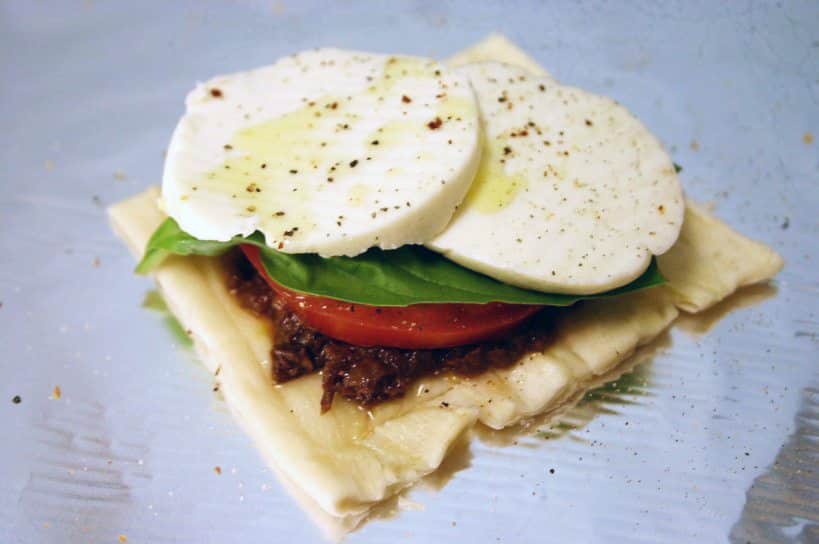Here we are already at the 4th month of Cheesepalooza. This month we had to make mozzarella. Well the experience almost broke me. I’ll tell you more about it later but I required 4 attempts before I had success. I almost lost my desire to make cheese. Let me reassure you though I believe this was an isolated incident because I already made next month’s cheese and it is drying nicely on the counter. Come back in a month to find out what it is.
In the beginning I used the classic 30 minute mozzarella that one will find all over the Internet. Some find it easy but many people claim their mozzarella attempts failures. It is not the easiest cheese to make at all. 1st try I got tough ricotta like cheese. 2nd try I got nice ricotta so that was not a waste. 3rd try there was not solidification at all. No protein and no fat solid materialized…puff…gone???
I was at my wit’s end. I was freaking out, discouraged, upset, mad, and I used a lot of 4 letter words. I was almost too angry to give up. I had given up the night before. Then I came across this blog post where the author had an identical mozzarella crisis as mine and she found a recipe that worked! From a Korean website! I had to try and I also like the fact that it was half a batch. It worked! OK the milk almost curdled and I did not get a nice white gelatinous surface, but with the microwave heating it did melt and turn into mozzarella texture. I was so freaking excited. I was so happy I forgot to add the salt. So it was hardly the best mozzarella but I did it.

Mozzarella
Ingredients
- 1/8 teaspoon or tablet of rennet
- 1/2 teaspoon milk A at room temperature
- 900 ml milk B
- 1/8 teaspoon citric Acid
- 1/8 teaspoon salt
Instructions
- Dissolve the rennet in milk A. Wait 30 minutes.
- Pour milk B into a pot, and heat to 90°F.
- Dissolve the acid in 1/4 cup water. When the milk is at 90°F pour in the citric acid. Let it sit for 10 minutes.
- Stir in the rennet and milk A solution into milk B. Stir for two minutes.
- Put the lid on and let it set for 30 minutes. You're trying to achieve a "clean break" which is when the milk sets. Wait longer if need be (some people wait 3 hours).
- Line a colander with a cheesecloth. Pour the curds and whey into the cheesecloth and let it drain.
- Gather the ends of the cheesecloth and massage the bag to drain the whey until it resembles a solid mass of curds.
- Microwave for 1 minute. Drain the whey
- Microwave in 20-30 second increments 2-3 times until the cheese is no longer releasing whey. You want to get a reading of 135°F.
- It's time to knead the cheese a bit until you get the stretch texture of mozzarella. I recommend using gloves as it gets really hot. Add salt and knead a bit.
- Shape and drop it into some cold water to "set" it.
So what did I learn and where may I have gone wrong?
Was it the milk? As far as I know we do not have ultra-pasteurized milk in Quebec. It is not indicated on the containers. I searched the websites of the local milks and the best information I got was that milk was pasteurized the standard way but still at a higher temperature. And I am in the city without a farmer connection. I tried 3 different milk companies. I don’t know if that was one of the issues. I did however come across this article that explains how to prepare milk ideal for cheese making from cream and milk powder. I did not use it for this cheese however but for next month’ s cheese. Here is the link but I will discuss it more in detail next month.
Was it the water? OK I admit the 2 first tries I forgot to use bottle water. City tap water with chlorine is a no no.
Was it the Citric acid? I think this was my main problem for 2 reasons. First I think the milk was over acidified with the quantity required in the recipe. That is why it curdled so fast but I have no acid measuring device. Second I read after 2 tries that I probably did not mix in the citric acid the right way. You have to pour the dissolved citric acid slowly while stirring vigorously. I really noticed the difference.
Special ingredients this month: Citric Acid and RennetI am glad in the end I stuck with it. My friends and colleagues definitely called me persistent. I won’t be making it again any time soon though. With my mozzarella finally in hand I made these lovely little Mozzarella Tomato and Black Olive Tarts. What a hit these were! Have you almost given up on a recipe after several attempts? Did you finally succeed?

If you want to learn more about cheese making check out my past posts on











I would love to make mozzarella one day and thanks for showing us that it is indeed possible. I have read so many mozzarella failures that I was sure that I’d be one too.
Congratulations for succeeding with this challenge!!! We saw the pic at http://www.acanadianfoodie.com/ and had to read your whole adventure. We are impressed by your perseverance, but mostly for how good that mozzarella looks so thank you for never giving up!
Cheers!
I am so impressed that you kept at it… this really is a challenging cheese. It looks like you ended up with some beautiful cheese (and tarts) out of that perseverance though, so congratulations!
wow!! good job sister! i always want to make my own cheese. and i adore those little tarts – what i wouldn’t give for one of those right now.
thank you for sharing with us at the Wednesday Fresh Foods Link Up! I hope to see you again this week with more seasonal & fresh/real food posts. xo, kristy
Evelyn!
Kudos to your perseverance! I believe we have all been there – but, I have someone to call to come over and hold my hand so we can make whatever is my nemesis with me – so that I know I will succeed. Do you have Mary Karlin’s book? I am just so surprised you didn’t try the Junket or the Traditional recipes. The traditional recipe is a PAIN in that it takes a long time, but, take a look at my notes at the bottom of the round up page and you will find out why I like it so much! Still haven’t posted my post on that one. I do agree, the microwave makes a huge difference!
Your cheese looks delicious – and you can add salt!
XO
Valerie
Your mozzarella looks wonderful! It’s worth at the end, and I want to make it one day on my own too!
This looks and sounds amazing! I have never made cheese, but I think the time has come…thanks for your tutorial! 🙂
Omg, it drives me crazy when things won’t go right, and I also curse like a drunken sailor until I figure it out!!! Good for you – looks like it ended very well, and you will now have peace. ; )
Good for you for not giving up Evelyne. I too would have used many four letter words, hehe:) Your mozzarella looks great! Now I’m craving some:)
I am glad you did not give up…looks perfect!
wow! i am impressed be your perserverance 🙂 i would have given up…lol :S
the only cheese i make at home is paneer (the indian cheese) and it looks wayyy simpler to make than mozzrella. but, maybe i should try dabbling my hands in making different cheeses… it could be fun 😉
Wow…I’m really out of the loop. No idea how missed this cheesepalooza because I’ve wanted to make mozzarella for ages. Looks like I won’t be able to get it in on time..but I will try…since yours looks so amazing! Sorry for the lack of comments lately..catching up now! xo
Hooray for your perseverance! Your mozzarella looks perfect!!! I may hold off trying this one…I’m not quite as patient as you 🙂
It sure looks delicious—I bet worth the 4 attempts! =)
Answering your question, YES! Being Macaron my latest experience hehe
I’m happy that you finally succeeded, and I love that you used Korean style bowl for your Korean recipe. Great looking mozzarella, I so want to make cheese one day!
Ah yes that was an awesome series your macarons Renata. Total fluke my bowls are Korean in design but so true!